
The Brown-headed barbet is an Asian barbet species native to the Indian subcontinent, where it inhabits tropical and subtropical moist broadleaf forests. It is widespread, with its range stretching from the Terai in southern Nepal in the north to Sri Lanka in the south, encompassing most of peninsular India, and listed as Least Concern on the IUCN Red List. It is an arboreal species of gardens and wooded country which eats fruit and insects. It is fairly tolerant of humans and often seen in city parks. It nests in a tree hole, laying 2-4 eggs. It forages on mangoes, ripe jackfruit, papaya, banana, figs and similar cultivated fruit trees. Its habitat includes urban and country gardens; it tends to eschew heavy forest. It nests in a suitable hole in a tree that it will often excavate. Both sexes incubate the eggs and often communicate with each other using their Kura, kura calls.

The crimson-fronted barbet, also called Sri Lanka barbet, is an Asian barbet endemic to Sri Lanka where it inhabits tropical moist lowland forests up to 1,300 m (4,300 ft) elevation.
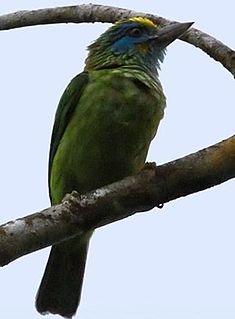
The yellow-fronted barbet is an Asian barbet, which is an endemic resident breeder in Sri Lanka, where it inhabits subtropical and tropical moist forests, wetlands, plantations and rural gardens up to an altitude of 2,000 m (6,600 ft). It has green plumage with a yellow crown and blue patches below the eyes, on the throat and the chin. It is 21–22 cm (8.3–8.7 in) long and weighs 57–60 g (2.0–2.1 oz). It feeds on berries, fruits and occasionally insects. It nests in a tree hole, where it lays 2-3 eggs.
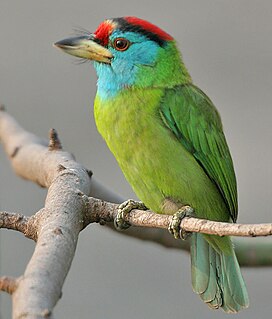
The blue-throated barbet is an Asian barbet native to the foothills of the Himalayas and Southeast Asia. It inhabits lowland and montane forests at elevations of 200–2,000 m (660–6,560 ft). It has bright green, blue and red plumage. The barbets get their name from the bristles which fringe their heavy bills; this species eats fruits and insects.
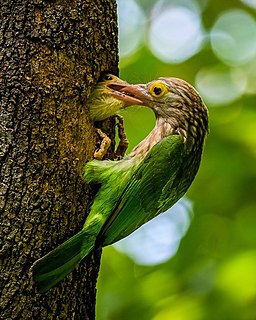
The lineated barbet is an Asian barbet native to the Terai, the Brahmaputra basin to Southeast Asia. It is a frugivore and nests in holes of tree trunks.
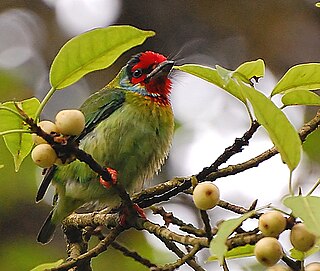
The Malabar barbet is an Asian barbet native to the Western Ghats in India. It was formerly treated as a race of the crimson-fronted barbet. It overlaps in some places with the range of the coppersmith barbet and has a similar but more rapid call.
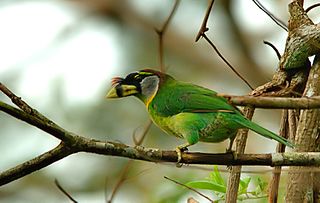
The Asian barbets are a family of bird species, the Megalaimidae, comprising two genera with 35 species native to the forests of the Indomalayan realm from Tibet to Indonesia. They were once clubbed with all barbets in the family Capitonidae but the Old World species have been found to be distinctive and are considered, along with the Lybiidae and Ramphastidae, as sister groups. In the past the species were placed in three genera, Caloramphus, Megalaima and Psilopogon, but studies show that Psilopogon to be nested within the clade of Megalaima. Since members of this clade are better treated under a single genus, they have been moved to the genus Psilopogon which was described and erected earlier than Megalaima and is therefore chosen on the basis of taxonomic priority principles. Nearly all members of the family are now in the genus Psilopogon, with the exception of those in Caloramphus, which are thought to have genetically diverged from the common ancestor around 21.32 million years ago. The latter species are distinct enough to warrant placement in a subfamily Caloramphinae. The family name is derived from that of the genus Megalaima which means ‘large throat’, from the Greek mega and laimos.

The great barbet is an Asian barbet native to the Indian sub-continent and Southeast Asia, where it inhabits foremost forests up to 3,000 m (9,800 ft) altitude. It has been listed as Least Concern on the IUCN Red List since 2004 because of its wide distribution.
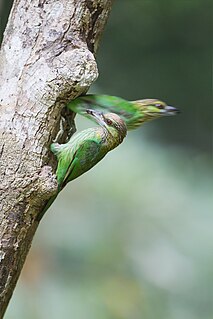
The green-eared barbet is an Asian barbet.

The golden-throated barbet is an Asian barbet native to Southeast Asia, where it inhabits foremost forests between 900 and 2,700 m altitude. It is listed as Least Concern on the IUCN Red List because of its wide distribution and stable population.

The blue-eared barbet is a barbet in the Megalaimidae family native to mainland Southeast Asia. Because of its wide distribution and stable population it is listed as Least Concern on the IUCN Red List.

The black-browed barbet is an Asian barbet native to Peninsular Malaysia and Sumatra, where it inhabits foremost forests between 600 and 2,000 m altitude. It is listed as Least Concern on the IUCN Red List because of its wide distribution and stable population.

The flame-fronted barbet is an Asian barbet native to Java and Bali. It has a green plumage, a yellow-orange forehead, a blue nape, and an orange crescent on the chest. It is about 19.5–23 cm (7.7–9.1 in) long and weighs 61–79 g (2.2–2.8 oz). Its natural habitats are subtropical or tropical moist lowland forest and subtropical or tropical moist montane forest.
The mountain barbet is a species of bird in the family Megalaimidae. It is endemic to the Southeast Asian island of Borneo. Its natural habitats are subtropical or tropical moist lowland forests and subtropical or tropical moist montane forests.

The red-crowned barbet is a species of bird in the family Megalaimidae. It is found in Brunei, Indonesia, Malaysia, Myanmar, Singapore, and Thailand. Its natural habitats are subtropical or tropical moist lowland forests and plantations. It is threatened by habitat loss.
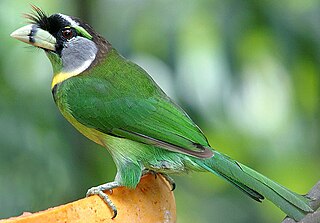
The fire-tufted barbet is a species of bird in the Asian barbet family Megalaimidae. It is native to Peninsular Malaysia and Sumatra, where it inhabits tropical moist lowland and montane forests. It has been listed as Least Concern on the IUCN Red List since 2004. Its scientific name was proposed by Salomon Müller in 1836, who described a barbet from Sumatra.

The Taiwan barbet is a species of bird endemic to the country of Taiwan.

The Chinese barbet is a bird in the family Megalaimidae. The species was first described by Robert Swinhoe in 1870. It is endemic to southern China.

The yellow-eared barbet is an Asian barbet native to Java and Bali. It inhabits shrubland and forest up to an altitude of 2,000 m (6,600 ft).
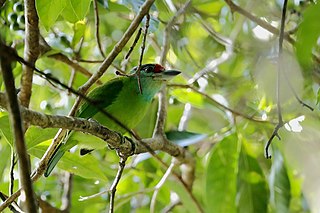
The turquoise-throated barbet is an Asian barbet found in Thailand. The barbets get their name from the bristles which fringe their heavy bills; this species eats fruits and insects. It used to be considered a subspecies of the blue-throated barbet.



















